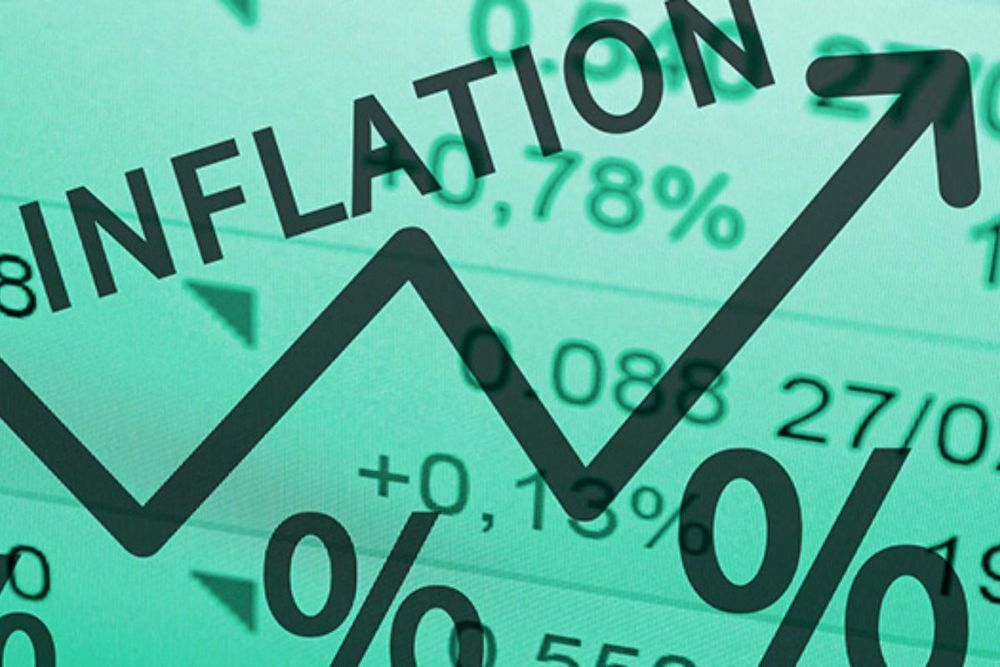The purpose of this research was to test the underlying hypotheses. That is, to measure the extent to which annual inflation rate significantly influences annual GDP growth rate within the Ghanaian economy and the global economy. Data in Tables 1, 2 and 8; and Figures 3 through 5, 11 and 12 proved useful to the analysis in this section. Columns 2 and 5 in Table 1; and Figures 3 and 4 present historical data on Ghana’s annual inflation values (1965 through 2020); and GDP growth rates (1961 through 2020).
However, application of data on both inflation and GDP growth to the main statistical analysis was limited to 1965 to reflect the earliest available data on annual inflation rates. Data on Ghana’s annual inflation values and GDP growth rates presented in columns 2 and 5 in Table 1 were accessed from the database of the World Bank (2021d&g), MacroTrends (2020b) and O’Neill (2021b); whereas data in column 4 in the table on annual gross domestic product values were accessed from MacroTrends (2020a) and O’Neill (2021a). Further, data on annual inflation change in column 3, Table 1, were accessed from MacroTrends (2020b) and the World Bank (2021g).
Economists perceive inflation as a reflection of the state of rising price levels; whereas deflation presents useful information on falling price levels; but not sudden fall or one-time fall in prices. Further, it reflects an increase in the value of money or purchasing power of money. However, disinflation occurs when inflation rate begins to slow down within given economies. The nature of inflation is presumed not to be uniform within an economy at all times. As a result, most economists consider it prudent to distinguish between various forms of inflation.
Analysis of the different types of inflation becomes paramount when economists attempt to examine its distributional and other effects; and to make recommendations for the implementation of policies that would curb inflation. Depending on the performance of an economy invariably through the ingenuity of the economic management team, a country may record mild or creeping, walking, running, galloping or hyperinflation.
A careful review of data in Table 1, columns 2 and 3; and Figures 3 and 4 reveal variations in annual inflation rates; and changes in annual inflation rates recorded within the Ghanaian economy from 1965 through 2020. The changes in inflationary levels within the economy during the period were non-linear. That is, changes observed in inflationary rates were not consistently the same over given fiscal periods. For instance, the annual rate of inflation during 2017 (12.37%) was 5.08% less than the rate recorded during the previous year (17.45%). However, the annual inflation rate during 2016 (17.45%) was 0.30% higher than the rate recorded during 2015 (17.15%).
Table 1: Historical Data on Ghana’s Inflation, GDP & GDP Growth Rates – 1960 – 2020
| Year | Annual Inflation Rate | Annual Inflation Change | GDP Value in US$ Billions | GDP Growth Rate |
| 2020 | 9.95% | 2.77% | 67.34 | 0.88% |
| 2019 | 7.18% | -0.63% | 66.98 | 6.48% |
| 2018 | 7.81% | -4.56% | 65.56 | 6.26% |
| 2017 | 12.37% | -5.08% | 59 | 8.14% |
| 2016 | 17.45% | 0.30% | 55.01 | 3.45% |
| 2015 | 17.15% | 1.66% | 48.56 | 2.18% |
| 2014 | 15.49% | 3.82% | 53.66 | 2.90% |
| 2013 | 11.67% | 4.54% | 62.41 | 7.31% |
| 2012 | 7.13% | -1.60% | 41.27 | 9.29% |
| 2011 | 8.73% | -1.98% | 39.34 | 14.05% |
| 2010 | 10.71% | -8.54% | 32.20 | 7.90% |
| 2009 | 19.25% | 2.73% | 25.98 | 4.84% |
| 2008 | 16.52% | 5.79% | 28.53 | 9.15% |
| 2007 | 10.73% | -0.18% | 24.76 | 4.35% |
| 2006 | 10.92% | -4.20% | 20.41 | 6.40% |
| 2005 | 15.12% | 2.49% | 10.73 | 5.90% |
| 2004 | 12.62% | -14.05% | 8.88 | 5.60% |
| 2003 | 26.67% | 11.86% | 7.63 | 5.20% |
| 2002 | 14.82% | -18.09% | 6.17 | 4.50% |
| 2001 | 32.91% | 7.71% | 5.31 | 4.00% |
| 2000 | 25.19% | 12.78% | 4.98 | 3.70% |
| 1999 | 12.41% | -2.22% | 7.72 | 4.40% |
| 1998 | 14.62% | -13.26% | 7.48 | 4.70% |
| 1997 | 27.89% | -18.68% | 6.89 | 4.20% |
| 1996 | 46.56% | -12.90% | 6.93 | 4.60% |
| 1995 | 59.46% | 34.59% | 6.47 | 4.11% |
| 1994 | 24.87% | -0.09% | 5.44 | 3.30% |
| 1993 | 24.96% | 14.90% | 5.97 | 4.85% |
| 1992 | 10.06% | -7.98% | 6.41 | 3.88% |
| 1991 | 18.03% | -19.23% | 6.60 | 5.28% |
| 1990 | 37.26% | 12.04% | 5.89 | 3.33% |
| 1989 | 25.22% | -6.14% | 5.25 | 5.09% |
| 1988 | 31.36% | -8.46% | 5.20 | 5.63% |
| 1987 | 39.82% | 15.25% | 5.07 | 4.79% |
| 1986 | 24.57% | 14.26% | 5.73 | 5.20% |
| 1985 | 10.31% | -29.36% | 4.50 | 5.09% |
| 1984 | 39.67% | -83.21% | 4.41 | 8.65% |
| 1983 | 122.87% | 100.58% | 4.06 | -4.56% |
| 1982 | 22.30% | -94.21% | 4.04 | -6.92% |
| 1981 | 116.50% | 66.43% | 4.22 | -3.50% |
| 1980 | 50.07% | -4.37% | 4.45 | 0.47% |
| 1979 | 54.44% | -18.65% | 4.02 | -2.51% |
| 1978 | 73.09% | -43.36% | 3.66 | 8.48% |
| 1977 | 116.45% | 60.37% | 3.19 | 2.27% |
| 1976 | 56.08% | 26.26% | 2.77 | -3.53% |
| 1975 | 29.82% | 11.69% | 2.81 | -12.43% |
| 1974 | 18.13% | 0.45% | 2.89 | 6.85% |
| 1973 | 17.68% | 7.62% | 2.47 | 2.88% |
| 1972 | 10.07% | 0.51% | 2.11 | -2.49% |
| 1971 | 9.56% | 6.53% | 2.42 | 5.22% |
| 1970 | 3.03% | -4.29% | 2.22 | 9.72% |
| 1969 | 7.32% | -0.58% | 1.96 | 6.01% |
| 1968 | 7.89% | 16.32% | 1.67 | 0.37% |
| 1967 | -8.42% | -21.66% | 1.75 | 3.08% |
| 1966 | 13.24% | -13.21% | 2.13 | -4.26% |
| 1965 | 26.44% | -13.21% | 2.05 | 1.37% |
| 1964 | – | – | 1.73 | 2.21% |
| 1963 | – | – | 1.54 | 4.41% |
| 1962 | – | – | 1.38 | 4.11% |
| 1961 | – | – | 1.30 | 3.43% |
| 1960 | – | – | 1.22 | – |
Sources: MacroTrends (2020a & 2020b); World Bank (2021b, d, & g)
Further, the rate recorded during2009 (19.25%) remained 8.54% less than the annual inflation rate recorded during 2010 (10.71%), but 2.73% higher than the rate recorded during 2008 (16.52%); albeit the latter rate (16.52%) was 5.79% in excess of the annual inflation rate recorded during 2007 (10.73%). Moreover, the effect of inflation recorded during 2014 (15.49%) on the Ghanaian economy may be more than double the effect of the rate recorded during 2012 (7.13%).
It is worth-emphasising the observed variations in annual inflation rates and the attendant changes in rate (increases or decreases) reflect differences in approach to effective management of the Ghanaian economy over the years. Further, the variations reflect differences in the interplay of external and internal macroeconomic and microeconomic factors with significant influence in determination of future direction of the Ghanaian economy.
Data in Table 1, columns 2 and 3; and Figures 3 and 4 affirm, it is very likely for the pace and intensity of inflation to differ at different time periods; and likely for inflation to have varied causative factors. Further, inflation may be categorised in tandem with governments’ reactions to inflationary trends. This provides justification for the different forms of inflation observed in contemporary economies throughout the world.
As affirmed in prior sections, it remains possible for an economy to experience currency inflation, which is the inflation borne-out of governments’ decision to print more currency notes into the economy. Further, an economy is saddled with credit inflation when loans and advances are sanctioned for businesses and the general public in excess of the actual needs of the economy. Generally, this form of inflation is encouraged through the operations of lending and other financial institutions within the economy (Dutta, n.d.).
During early and mid-2000s, Ghana remained one of the beneficiaries from the Heavily Indebted Poor Countries (HIPC) initiative of the International Monetary Fund, the World Bank and some of its affiliates. The HIPC initiative reduced the national debt considerably. Further, it increased the extent of national fiscal space; and increased funds availability within the Ghanaian economy. To ensure these excess funds which were available to financial institutions acquired financial value, banks intensified their financial literacy campaign and education; and encouraged small businesses, including retailers, to apply for and access loans at reduced interest rates. In essence, the Ghanaian economy experienced credit expansion through the operations of financial institutions during the period.
Figure 3: Historical Data on Ghana’s Inflation, GDP & GDP Growth Rates – 1960 – 2020

However, the response of large and small businesses; and individuals to the “credit-call” of the banks was the creation of excess liquidity in the economy. Another effect of the application of this modern monetarist approach that is, increasing the amount of money directly in the hands of households and businesses, was its contribution to significant increase in annual rate of inflation from 14.82% during 2002 to 26.67% during 2003; as illustrated in Table 1; and Figures 3 and 4.
The excess liquidity created by credit expansion induced excess aggregate demand over aggregate supply of certain goods and services within the economy. The low productive capacity comparative to high aggregate demand led to upward price adjustments and hence, inflation. In essence, the applied monetary strategy resulted in credit inflation during the period.
Nonetheless, the annual rate of inflation recorded during 2004 (12.62%) was less than half the rate recorded during 2003 (26.67%); suggesting effective identification and application of monetary policies to stem the negative growing tide of credit inflation within the Ghanaian economy. Varied inflation rates recorded during 2005 through 2008 (15.12%; 10.92%; 10.73%; and 16.52%) remained lower than the rate recorded earlier in 2003 (26.67%); affirming further, effectiveness of the monetary policy strategies implemented to mitigate the adverse effects; and to control credit inflation within the economy during the period under review.
Hyperinflationary periods tend to increase the financial fortunes of people engaged in speculative businesses as their pronouncements create artificial shortages of commodities; and increase in the prices of these commodities. The balance of payment account of economies is negatively impacted during periods of hyperinflation; as the value of total exports decreases, comparative to the value of imports; and a wide imbalance between earnings from total exports and payments on total imports is recorded.
Confidence of the investment community in the monetary policies and arrangements within the economy is eroded during periods of galloping inflation. The loss of confidence leads to capital flight to foreign economies with relatively stable inflationary trends. The capital flights result in scarcity of resources necessary for accelerated economic development and growth. The rate and value of capital flight determine the magnitude of the scarcity of resources needed for national development (Dutta, n.d.).
The Ghanaian economy succumbed to hyperinflation during seven fiscal periods, representing 12.5% of the fifty-six-year fiscal periods. Available data in Table 1; and Figures 3 and 4 affirm hyperinflation was specifically recorded during the ensuing fiscal periods: 1976 (56.08%); 1977 (116.45%); 1978 (73.09%); 1979 (54.44%); 1980 (50.07%); 1981 (116.50%); and 1983 (122.87%). The analysis suggests Ghana’s heightened inflationary levels were recorded during the foregoing periods. The average rate of inflation recorded over the seven-year period was approximately 84.21%.
Generally, the real value of national revenue mobilised through taxes is reduced by hyperinflation; and this affects the value of available investible national resources. The analysis affirms the unanimity of policymakers and economists on the threats of rising price levels within global economies. Indeed, the economic repercussions of hyperinflation are devastating and disastrous as evidenced in prior and recent periods in countries such as Weimar Germany, Poland, Hungary, Austria, Argentina, Bolivia, Brazil, Venezuela and Zimbabwe.
Negative GDP growth is characteristic of weak performing global economies. The weak performance could be attributed to varied internal and external shocks; as well as the inefficiency and ineffectiveness of managers of the implied economies. Data in Figures 3 and 4 reveal Ghana’s economy was characterised by eight distinct weak performance periods from 1960 through 2020. Internal and external economic shocks led to the record of negative GDP growth rates during the following fiscal periods: 1966 (-4.26%); 1972 (-2.49%); 1975 (-12.43%); 1976 (-3.53%); 1979 (-2.51%); 1981 (-3.50%); 1982 (-6.92%); and 1983 (-4.56%).
The first (-4.26%) and second (-2.49%) negative GDP growth rates coincided with the first two coup d’états and military take-overs (1966 and 1972); and fairly reflect challenges to effective management of Ghana’s economy by military governments during their first year in political office. The negative GDP growth recorded during 1982 (-6.92%) attested further to the challenges to effective and efficient management of Ghana’s economy by military governments during their respective first political administrative years.
The data in Table 1; and Figures 3 and 4 indicate two (25%) of the eight negative GDP growth rates (-2.51% in 1979) and (-3.50% in 1981) were recorded during the first and last years of the only democratically elected government under the Third Republic. The elected government under the third republic was sworn into office on 24th September, 1979; implying the first three quarters of the fiscal year were effectively under the economic “watch” of military governments (Supreme Military Council (SMC) II; and Armed Forces Revolutionary Council (AFRC)). Some analysts argued, the real weak economic fundamentals inherited by the late Dr. Hilla Limann’s administration from the military government affected the country’s economic performance during his early years in office as President during the third republic.
The remaining six negative GDP growth rates (75%) were recorded under the stewardship of military governments. Although respective GDP growth rates recorded during fiscal periods 1975 (-12.43%) and 1976 (-3.53%) were negative, the respective rates recorded during 1977 (2.27%) and 1978 (8.48%) were positive. Perhaps, the right to host the African Cup of Nations during 1978 contributed strongly to the boost in Ghana’s GDP growth (8.48%) during the year, relative to the rate (2.27%) recorded during the preceding year. Data in Figures 3 and 4 further suggest growth in Ghana’s economic performance remained steady from 1984 through 2020; as no negative and many outlying GDP growth rates were recorded during the period.
Figure 4: Trend in Inflation and GDP Growth Rates in Ghana – 1961 – 2020

Many contemporary economists are of the opinion sustainable economic growth without any potential side effects is within the range of 2.5% and 3.5%. Per the foregoing definition, Ghana’s economy has experienced only seven sustainable growth performances without potential side effects. These seven growth rates were equivalent to 11.67% of the sixty annual GDP growth rates recorded from 1961 through 2020. The sustainable growth rates without potential side effects were recorded during the following fiscal periods: 1961 (3.43%); 1967 (3.08%); 1973 (2.88%); 1990 (3.33%); 1994 (3.30%); 2014 (2.90%); and 2016 (3.45%).
Data on selected macroeconomic indicators related to performance of the Ghanaian economy under various political administrations and their respective economic management teams since the First Republic through the Fourth Republic are outlined in Tables 2 and 3; and Figures 5 and 6. Statistics in Tables 2 and 3; and Figures 5 and 6 drew essentially on data in Table 1; and Figures 3, 4 and 7; implying available data in the table and figures proved quite useful to the analysis in this section.
Data in column 1, Tables 2 and 3; and Figures 5 and 6 cover the period, 1960 through 2020; and reflect respective annual average performances of each political administrative term during the period. Data in column 2, Table 1; and Figures 3 and 4 proved useful to the computation of annual average inflation rates for the respective fiscal periods in column 2, Table 2; and Figure 5. The respective annual average GDP growth rates and annual average GDP values in columns 3 and 4, Table 2; and Figure 5 were computed based on the available data in respective columns 5 and 4 in Table 1; and Figure 3.
Fiscal periods 1960 through 1965; 1970 and 1971; and 1980 and 1981 in column 1, Tables 2 and 3; and Figures 5 and 6 fairly reflect the respective administrative periods during the first, second and third republics. Further, fiscal periods 1966 through 1969; 1972 through 1979; and 1982 through 1992 affirm periods of military rule; whereas fiscal periods 1993 through 2020 reflect various periods of democratic stewardships during the fourth republic in Ghana’s economic and political history. The Fourth Republican Constitution of Ghana allows for four-year two presidential terms. The Constitution came into force from 1st January 1993 through the research period. This explains the consistency in the four-year intervals presented in rows 7 through 13 in column 1, Tables 2 and 3.
Table 2: Annual Averages for Inflation, GDP Growth and GDP Values – 1960 – 2020
| Year | Annual Average Inflation Rate | Annual Average GDP Growth Rate | Annual Average GDP (US$) |
| 1960 – 1965 | 26.44% | 3.11% | 1.54 Billion |
| 1966 – 1969 | 5.01% | 1.30% | 1.88 Billion |
| 1970 – 1971 | 6.30% | 7.47% | 2.32 Billion |
| 1972 – 1979 | 46.97% | -0.06% | 2.99 Billion |
| 1980 – 1981 | 83.29% | -1.52% | 4.34 Billion |
| 1982 – 1992 | 34.68% | 3.22% | 5.20 Billion |
| 1993 – 1996 | 38.96% | 4.22% | 6.20 Billion |
| 1997 – 2000 | 20.03% | 4.25% | 6.77 Billion |
| 2001 – 2004 | 21.76% | 4.83% | 7.00 Billion |
| 2005 – 2008 | 13.32% | 6.45% | 21.11 Billion |
| 2009 – 2012 | 11.46% | 9.02% | 34.70 Billion |
| 2013 – 2016 | 15.44% | 3.96% | 54.91 Billion |
| 2017 – 2020 | 9.33% | 5.44% | 64.72 Billion |
Source: Computed and compiled by the Researcher
Dorrance (1963) asserted, the impacts of effective liquidity have the tendency to exert utmost influence on the forms of investment ventures pursued by investors during inflationary periods; albeit they could also work to ensure reduction in the total flow of resources available for investment. In an economy characterised by inflation, if the prevailing price rate increase is 20% per year, the price rate increase for the following year would be approximately 10% or more than 40%; thereby illustrating uncertainty surrounding inflation. Moreover, Dorrance (1963) argued, the community’s incentive for liquidity is heightened when there is uncertainty in relation to future direction of prices. The foregoing assertion fairly reflects the distribution of annual average inflation rates recorded within the Ghanaian economy from 1965 through 2020 and presented in column 2, Table 2; and Figure 5.
The highest annual average rate of inflation within the Ghanaian economy was recorded during the period 1980 – 1981 (83.29%). This rate was about 1.77 times the annual average recorded during 1972 – 1979 (46.97%); nearly 2.40 times the annual average recorded during 1982 – 1992 (34.68%); and approximately 3.15 times the annual average recorded during 1960 – 1965 (26.44%). The foregoing analysis affirms the magnitude of the 1980 – 1981 annual average inflation rate (83.29%) and its relative effect on comparative periods.
The lowest annual average inflation rate (5.01%) was recorded during 1966 through 1969. This rate was only 0.13 times and 0.25 times the respective annual averages recorded during 1993 – 1996 (38.96%) and 1997 – 2000 (20.03%). The respective annual average inflation rates recorded during fiscal periods 1972 – 1979 (46.97%) and 1993 – 1996 (38.96%) remained the second- and third-highest during the period; with the former being nearly 1.21 times the latter.
Prior discussions revealed, profit motives of lending institutions often lead to credit inflation in economies. Generally, excess aggregate demand over aggregate supply is inspired when excess liquidity is created through credit expansion. The latter leads to inflation in the form of rising price levels. Moreover, it is likely for planned public spending to exceed national revenue during a given fiscal period. Under the circumstance, the implied economy may experience deficit-induced inflation. The deficit financing gap resulting from the foregoing strategy may be met through government’s resolve to print more currency notes; or resort to borrowing via the central bank. Economists describe the increase in price levels arising from printing of more currency notes to mitigate the financing gap as deficit-induced inflation.
Trends in Figure 4 reveal Ghana’s inflation “bubble bursts” manifested strongly from 1976, when the first galloping inflation rate (56.08%) was recorded; through 1983, when the last hyperinflation rate (122.87%) was recorded. The hyperinflation rates recorded during the foregoing periods remained spread across; and inherent in some fiscal periods and their respective annual averages – (1972 – 1979 = 46.97%; 1980 – 1981 = 83.29%; 1982 – 1992 = 34.68%) – as presented in Table 2 and Figure 5.
Analysis of the data in column 2, Table 2 and Figure 5 suggests, irrespective of the political period, the best (5.01%) and worst (83.29%) annual average inflation rates were recorded during 1966 – 1969 and 1980 – 1981. However, when narrowed to the fourth republic, respective annual average inflation rates recorded during fiscal periods 2017 – 2020 (9.33%) and 1993 – 1996 (38.96%) remained the best and worst. Respective annual averages recorded during 2009 – 2012 (11.46%) and 2005 – 2008 (13.32%) remained the second-best and third-best.
Figure 5: Ghana’s Annual Average Inflation, GDP Growth and GDP Values – 1960 – 2020
As stated earlier, rows 7 through 13 in column 1, Tables 2 and 3 present the years’ interval (four years) for each elected government’s administrative term in office during the fourth republic. Respective columns 2 in Tables 2 and 3 shed important light on annual average inflation rate and annual average population size under each political administration from 1960 through 2020.
Respective columns 3 and 4 in Table 2 present the annual average GDP growth rates and annual average GDP values; while respective columns 3 and 4 in Table 3 depict the annual average GDP-to-annual average population ratio and annual average population increase during the period. The macroeconomic indicators outlined in the tables and figures reflect fairly the stewardship and direction of Ghana’s economy; and general performance of each elected government or otherwise, in terms of economic management, during the period.
Due to the uncertainty characterising future prices, the probability of business challenges erupting and unpredictable investment opportunities occurring is increased. The increase in probable occurrence of the foregoing events strengthens individuals and businesses’ desire for liquid assets for speculative and precautionary purposes. As prices continue to rise during periods of inflation, the real value of money and financial assets denominated in money suffers a decline; and this limits individuals and businesses’ ability to depend on them as store of liquidity during inflationary periods. For extended loan agreement period, it is likely for prices to rise during the interval between cash receipts and repayments. This makes it almost impossible for money and financial assets denominated in money to provide acceptable liquidity to bridge the gap between transactions (Dorrance, 1963).
Column 4 in Table 2 presents annual average GDP values for the respective fiscal periods outlined in column 1 in the table. The statistical distribution in column 4, Table 2, depicts steady increase in annual average GDP values during the first-four fiscal periods. However, the annual average recorded during fiscal period 1980 – 1981 (US$4.34 billion) was almost twice the annual average recorded during the previous period (US$2.99 billion). This new trend in annual average GDP values was sustained over five distinct fiscal periods: 1980 – 1981 (US$4.34 billion); 1982 – 1992 (US$5.20 billion); 1993 – 1996 (US$6.20 billion); 1997 – 2000 (US$6.77 billion); and 2001 – 2004 (US$7 billion).
However, the annual average recorded during 2005 – 2008 (US$21.11 billion) was more than triple the annual average recorded during the previous fiscal period (US$7 billion). The significant surge in annual average GDP values was sustained from 2005 – 2008 (US$21.11 billion) through 2017 – 2020 (US$64.72 billion); with the latter representing 206.59%, 86.51% and 17.87% increase over the respective annual average GDP values recorded during 2005 – 2008 (US$21.11 billion); 2009 – 2012 (US$34.70 billion); and 2013 – 2016 (US$54.91 billion).
In spite of the high annual average inflation rate recorded during 1980 – 1981 (83.29%), annual average GDP growth during the period was negative (-1.52%); implying weak average economic performance. Similarly, the high annual average inflation rate recorded during 1972 – 1979 (46.97%) did not reflect positively on growth performance (-0.06%) of the Ghanaian economy; suggesting non-existence of automatic positive relationship between higher inflation rate and increased total economic output. However, the relatively low annual average inflation rate recorded during 2009 – 2012 (11.46%) resulted in high annual average GDP growth (9.02%).
In the same vein, the low annual average inflation rate recorded during 1970 – 1971 (6.30%) was greeted with strong annual average GDP growth performance (7.47%). Thus, the analysis supports strongly the argument that higher inflation rate does not necessarily lead to higher economic growth; and that, higher inflation has the potential to impact negatively on growth performance. Conversely, low inflationary levels have the tendency to stimulate the economy towards positive and sustainable growth.
To mitigate the shortfalls associated with future price uncertainties, Dorrance (1963) noted, efforts would be made by economies, businesses and investors to obtain assets with expected increase in value during the interval prior to the investment opportunity or repayment period. The partial flight of investors into non-monetary assets remains the major source of many of the distortions found to be associated with inflation. Further, the phenomenon accounts for partial decline in the flow of resources to investment. The community’s reaction to inflation is evidenced in the decision to hold on to limited amount of money; or dispose of the money through purchases and savings.
As a reiteration, the annual average GDP growth rates for the respective fiscal periods in Table 2 and Figure 5 were computed using data in column 5, Table 1; and Figure 3. Analysis of the various four-year economic management periods in Ghana, as outlined in Table 2 and Figure 5 indicates fiscal periods 2009 through 2012 (9.02%); 1970 and 1971 (7.47%); and 2005 through 2008 (6.45%) recorded the respective highest, second-highest and third-highest annual average GDP growth rates from 1960 through 2020. The annual average growth rate for 2009 through 2012 (9.02%) remained 1.55% and 2.57% better than the respective annual averages recorded during fiscal periods 1970 and 1971 (7.47%); and 2005 through 2008 (6.45%).
Further, the annual average growth for 2009 through 2012 (9.02%) remained 3.58% superior to the annual average growth recorded during 2017 through 2020 (5.44%). The latter remained the fourth-highest annual average GDP growth from 1960 through 2020. Data in the table and figure affirm the respective annual average GDP growth rates recorded during 2001 through 2004 (4.83%); 1997 through 2000 (4.25%); 1993 through 1996 (4.22%); and 2013 through 2016 (3.96%) were successive in order of rankings to the preceding four major fiscal periods.
Long-term economic growth is stagnated when activities in the country are characterised by increasing rate of inflation. Economic savings are discouraged by hyperinflation; and capital formation within the economy is severely impacted when the level of savings is low. The extended consequence of decline in the rate of capital formation is stymied economic growth; with the attendant increase in unproductive investments, occasioned by rapid rise in price levels (Dutta, n.d.).
Data in the tables and figures affirm significant portion of Ghana’s annual inflation rates from 1965 through 2020 was in the running inflation category. More specifically, forty-seven (47) years of the fifty-six (56) enumerated fiscal years were characterised by running inflation. This implies running inflation constituted nearly 83.93% of the varied forms of economic inflation witnessed from 1965 through 2020.
Further analysis of data in Table 2 and Figure 5 affirmed annual average GDP growth rate of 4.23% was recorded over an eight-year period, spanning from 1993 through 2000; whereas the rate recorded during 2001 through 2008 was approximately 5.64%. The annual average GDP growth rate recorded during fiscal periods 2009 through 2016 was equivalent to 6.49%. This remained 0.85% and 2.26% better than the respective annual average GDP growth rates recorded during fiscal periods 2001 through 2008 (5.64%); and 1993 through 2000 (4.23%). Data in the table and figure affirm the worst annual average GDP growth rates were recorded during 1980 – 1981 (-1.52%) and 1972 through 1979 (-0.06%). Overall, macroeconomic performance of the Ghanaian economy in terms of growth was not impressive during the last two periods.
Dorrance (1963) argued, any inflation rate is practically unpredictable; and that, households’ desire for liquidity is little impacted when inflation is expected to proceed in a uniform rate. As the average inflation rate surges, variations in the rate become more pronounced. However, it is not far-fetched for price movements to be reasonably predicted in a stable economic environment. There are two identified effects of inflation on community’s desire for liquidity. These effects relate to the two basic reasons underlying why businesses and individuals would be interested in holding assets. These reasons include the precautionary motive and speculative motive. Evidently, inflationary effects extend to include the implications for economic growth; while population growth has the potential to stimulate an economy towards improved and increased performance.
Annual average GDP-to-annual average population ratios were computed to determine the average GDP per person during each political administrative term. The ratio is expressed as annual average GDP divided by annual average population. The ratio indicates the amount to be obtained by each person, should the average total economic value be shared among the average total population. The computed ratios are shown in column 3, Table 3 and Figure 6. The computed values in column 3, Table 3 drew essentially on data in Table 2, column 4; and Table 3, column 2.
However, values for annual GDP in column 4, Table 1; and Figure 3 proved useful to the computed data for annual average GDP in column 4, Table 2; whereas computed annual average population values in Table 3, column 2 were facilitated by the data on population in Figure 7. As noted earlier, population growth remains one of the identified pertinent factors that could cause increases in aggregate demand and influence upward price adjustments.
Dorrance (1963) revealed, the value of effective liquidity is often increased by inflation; and this increases individuals and businesses’ desire for effective liquidity. However, inflation tends to render the most generally accepted store of liquidity, including money and financial assets denominated in money, unattractive sources of protection.
The foregoing illustrations affirm how individuals and businesses’ desire for liquidity is strengthened; and how the original function of money and financial assets as store of liquidity is negatively impacted by inflationary trends. Heightened inflationary level could lead to surge in value of total economic output. Further, it has the potential to induce unsustainable growth in economies across the globe.
Statistical distribution in Table 3, column 3 affirms steady increase in annual average GDP per person during the first-five respective fiscal periods (1960 – 1965; 1966 – 1969; 1970 – 1971; 1972 – 1979; and 1980 – 1981); and a slight decline in the annual average (US$382.48) during the sixth fiscal period (1982 – 1992). The annual average GDP per person recorded during the fifth fiscal period, 1980 – 1981 (US$ US$387.42), represented 80.79%, 69.58%, 47.86% and 30.30% increase over the respective annual averages recorded during 1960 – 1965 (US$214.29); 1966 – 1969 (US$228.46); 1970 – 1971 (US$262.02); and 1972 – 1979 (US$297.33).
Table 3: Ghana’s Ann. Average GDP-To-Ann. Average Population Ratios – 1960 – 2020
| Year | Ann. Average Population | Ann. Average GDP – Ann. Average Pop. Ratio | Ann. Average Pop. Increase |
| 1960 – 1965 | 7,186,593 | US$214.29 | 3.13% |
| 1966 – 1969 | 8,229,000 | US$228.46 | 2.43% |
| 1970 – 1971 | 8,854,370 | US$262.02 | 2.63% |
| 1972 – 1979 | 10,056,054 | US$297.33 | 2.35% |
| 1980 – 1981 | 11,202,203 | US$387.42 | 2.48% |
| 1982 – 1992 | 13,595,542 | US$382.48 | 2.97% |
| 1993 – 1996 | 16,786,248 | US$369.35 | 2.77% |
| 1997 – 2000 | 18,589,339 | US$364.19 | 2.51% |
| 2001 – 2004 | 20,506,483 | US$341.36 | 2.49% |
| 2005 – 2008 | 22,680,367 | US$930.76 | 2.59% |
| 2009 – 2012 | 25,083,680 | US$1,383.37 | 2.49% |
| 2013 – 2016 | 27,540,817 | US$1,993.77 | 2.31% |
| 2017 – 2020 | 30,094,841 | US$2,150.54 | 2.20% |
Source: Computed and compiled by the Researcher
Further analysis of the data in Table 3, column 3; and Figure 6 affirms steady decline in the annual average GDP per person over the next four consecutive fiscal periods: 1982 – 1992 (US$382.48); 1993 – 1996 (US$369.35); 1997 – 2000 (US$364.19); and 2001 – 2004 (US$341.36). The sudden decline in values of annual average GDP per person reflects the sharp fall in annual average GDP growth rates from 7.47% during 1970 – 1971 to negative 0.06% and negative 1.52% during respective fiscal periods 1972 – 1979 and 1980 – 1981; as shown in Table 2 and Figure 5.
Although the annual average GDP growth rates recorded during respective fiscal periods 1982 through 1992 (3.22%); 1993 through 1996 (4.22%); 1997 through 2000 (4.25%); and 2001 through 2004 (4.83%) were sharp improvements over the negative annual average growths recorded during 1972 through 1979 (-0.06%); and 1980 to 1981 (-1.52%), they fell short of the annual average recorded during fiscal period 1970 to 1971 (7.47%).
In spite of the decline in annual average GDP growth, we observe steady increase in annual average population sizes during the period. Unfortunately, the geometric increase in annual average population size is counteracted with arithmetic surge in annual average economic growth; and this underlies, to a very large extent, the decline in annual average GDP per person recorded during some fiscal periods.
Figure 6: Trends in Ghana’s Ann. Av. GDP-To-Ann. Av. Population Ratios – 1960 – 2020

Dorrance (1963) opined, the monetary system of an economy operates on a set of assumptions. These include money serving as standard for debt repayment, store of value, numéraire and satisfactory medium of exchange. When an economy is characterised by price stability or gradual price increases, individuals and businesses tend to recognise and accept money for all economic purposes. Contrarily, persistently high increase in prices over extended periods would discourage the community from holding money for assumptions one and two mentioned above.
From the available data in Table 3 and Figure 6, we observe significant peak in annual average GDP per person during the last four respective fiscal periods: 2005 – 2008 (US$930.76); 2009 – 2012 (US$1,383.37); 2013 – 2016 (US$1,993.77); and 2017 – 2020 (US$2,150.54). The foregoing may be attributed to the fact that percentage increase in annual average population size during the respective fiscal periods 2005 – 2008 (2.59%); 2009 – 2012 (2.49%); 2013 – 2016 (2.31%); and 2017 – 2020 (2.20%) was out-paced by the respective increase in annual average GDP growth rates: 2005 – 2008 (6.45%); 2009 – 2012 (9.02%); 2013 – 2016 (3.96%); and 2017 – 2020 (5.44%). Data in Table 3; and Figures 6 and 7 reveal, in real terms, steady increase in Ghana’s annual average population size was observed during fiscal periods 1993 – 1996 (16,786,248) through 2017 – 2020 (30,094,841).
However, comparative to 1993 – 1996 (2.77%), we observe decline in annual average population increases (in percentage terms) from 1997 – 2000 (2.51%) through 2017 – 2020 (2.20%). The steady decline in percentage increase in annual average population seems to suggest the level of academic education; and national campaign on birth control are gaining currency and yielding the desired socio-economic dividend. This has the potential to ease pressures on current and subsequent elected governments to increase services delivery to meet the basic and essential needs of the population.
Figure 7: Trends in Ghana’s Annual Population & Percentage Increase – 1950 – 2020

Dorrance (1963) contended, economic adjustments attempted by individuals and businesses when future stable price periods are expected differ from the adjustments attempted when price instability is envisaged. In some cases, analysts are saddled with effective comparison of different sets of adjustments. Quite obviously, measurement of economic growth is subject to other complex forces such as the components of gross domestic product including government expenditure, private investment, consumption and net exports (total exports less total imports). Thus, measurement of effects of pervasive influence of inflation on economic growth may be a daunting task, though possible. Testing and analysis of the underlying research hypotheses would be presented in another series of this publication.

Table 8: Annual Global Inflation & Annual GDP Growth Rates – 1981 – 2020
| Year | Global Inflation Rate | Annual Change in Global Inflation Rate | Annual Global GDP Growth Rate | Annual Change in Global GDP Growth Rate |
| 2020 | 1.94% | -0.21% | -3.60% | -5.93% |
| 2019 | 2.15% | -0.27% | 2.33% | -0.70% |
| 2018 | 2.42% | 0.24% | 3.03% | -0.25% |
| 2017 | 2.18% | 0.69% | 3.28% | 0.67% |
| 2016 | 1.49% | 0.06% | 2.61% | -0.31% |
| 2015 | 1.43% | -0.91% | 2.92% | 0.05% |
| 2014 | 2.35% | -0.26% | 2.87% | 0.20% |
| 2013 | 2.61% | -1.12% | 2.67% | 0.15% |
| 2012 | 3.73% | -1.10% | 2.52% | -0.61% |
| 2011 | 4.82% | 1.48% | 3.12% | -1.19% |
| 2010 | 3.34% | 0.42% | 4.31% | 5.97% |
| 2009 | 2.92% | -6.03% | -1.66% | -3.25% |
| 2008 | 8.95% | 4.14% | 1.96% | -2.46% |
| 2007 | 4.82% | 0.53% | 4.32% | -0.05% |
| 2006 | 4.28% | 0.17% | 4.37% | 0.47% |
| 2005 | 4.11% | 0.73% | 3.90% | -0.51% |
| 2004 | 3.38% | 0.36% | 4.41% | 1.46% |
| 2003 | 3.02% | -0.01% | 2.95% | 0.78% |
| 2002 | 3.03% | -0.89% | 2.17% | 0.22% |
| 2001 | 3.92% | 0.36% | 1.95% | -2.47% |
| 2000 | 3.56% | 0.29% | 4.42% | 1.18% |
| 1999 | 3.26% | -1.83% | 3.25% | 0.69% |
| 1998 | 5.10% | -0.46% | 2.56% | -1.15% |
| 1997 | 5.55% | -1.12% | 3.70% | 0.27% |
| 1996 | 6.68% | -2.57% | 3.43% | 0.41% |
| 1995 | 9.25% | -1.31% | 3.02% | 0.07% |
| 1994 | 10.56% | 3.42% | 2.95% | 1.45% |
| 1993 | 7.14% | -0.68% | 1.49% | -0.28% |
| 1992 | 7.83% | -1.17% | 1.78% | 0.27% |
| 1991 | 9.00% | 0.55% | 1.51% | -1.47% |
| 1990 | 8.45% | 0.92% | 2.98% | -0.75% |
| 1989 | 7.53% | 0.36% | 3.73% | -0.90% |
| 1988 | 7.17% | 1.11% | 4.63% | 0.94% |
| 1987 | 6.06% | 0.07% | 3.69% | 0.25% |
| 1986 | 5.99% | -1.10% | 3.43% | -0.25% |
| 1985 | 7.10% | -1.22% | 3.68% | -0.79% |
| 1984 | 8.32% | -0.80% | 4.47% | 2.07% |
| 1983 | 9.11% | -1.18% | 2.40% | 1.87% |
| 1982 | 10.30% | -2.37% | 0.53% | -1.34% |
| 1981 | 12.66% | -2.37% | 1.87% | 0.01% |
Sources: MacroTrends (2021b&c)
Author’s Note
The above write-up was extracted from recent Publication on “Nexus between Inflation and GDP Growth” by Ashley, Andani, Sackey and Ackah (2024) in the International Journal of Business and Management (IJBM). DOI No.: 10.24940/theijbm/2024/v12/i1/BM2401-016
















